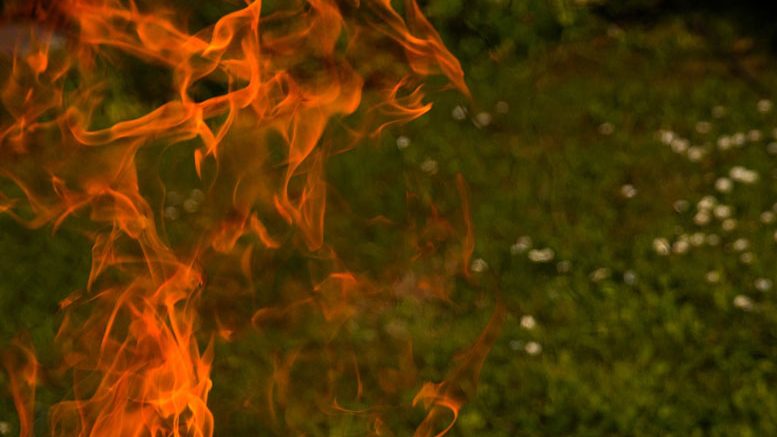WHAT IS HEAT STRESS? Potatoes are reasonably good at acclimating to the high temperatures that are normal for the Columbia Basin in the summer. It is the sudden spikes in temperature that result in stress. Heat stress occurs when a significant rise in temperature (usually, at least 10 degrees F above normal) occurs for long enough to affect plant growth and development. Factors that determine the intensity of heat stress include (1) temperature, (2) duration of exposure, and (3) rate of temperature increase.
PLANT RESPONSES TO HIGH TEMPERATURES: Potatoes and other plants respond to high temperatures in several ways. Many of the responses are biochemical, such as an increased production of antioxidants and heat-shock proteins. Others are heat avoidance responses including (1) leaf rolling or changed orientation, (2) senescence of lower leaves, (3) increased transpiration (for cooling via evaporative water loss), and (4) closing of stomata (to limit water loss).
SYMPTOMS: Most of the following pictures were taken by Tim Waters and Carrie Wohleb, WSU Extension, last week to illustrate some of the heat stress symptoms we are seeing on potatoes.
 |
LEAF CUPPING & FOLDING: The pictures (above) show Clearwater Russet with leaves that are cupping or folding in response to the heat. It usually starts with upward cupping at the leaf margins, and then progresses to inward rolling of the entire leaflet. I’ve seen lots of potato fields this week with leaflets folded like tacos. It is a heat-avoidance response, because leaf folding reduces the amount of surface area exposed to solar radiation. The leaves may recover when normal temperatures resume, or they may not if the stress continues for too long. The leaves may also become thick and leathery due to carbohydrate accumulation (translocation of carbohydrates from the leaves to tubers is another result of heat stress).
 |
WILTING: Wilting is a common symptom of heat stress (photo above left). Plants wilt when water losses via transpiration exceed water uptake. Wilting is more severe where soil water is inadequate, but some wilting can also occur in wet fields on really hot days. The wilting is not usually permanent; the plants usually recover overnight, or shortly after irrigation.
LEAF SENESCENCE & DROP: Accelerated sensescence of the older, lower leaves is a common response to heat stress. In extreme cases, several of the lower leaves will quickly die off (photo above middle).
TIPBURN & WIND INJURY: Tipburn is caused by excessive water loss from leaves under hot, dry, and windy conditions (photo above right). The injured area can extend beyond the leaf tips and edges. Tipburn and wind injury symptoms can look like those of late blight, but tipburn lesions are uniformly brown with abrupt margins between healthy and damaged tissue. Late blight lesions tend to have a light green or yellow zone surrounding the lesion. Tipburn tends to occur on plants in large areas of the field, but late blight is almost always clustered into hot spots. The pictures (below) show tipburn/wind injury symptoms, taken by a crop consultant last week, that could easily be mistaken for blight symptoms.
 |
LEAF DEVELOPMENT DURING HEAT STRESS: Potato leaves that develop during high temperatures are usually smaller. This is a common adaptation in arid environments because small leaves are better able to dissipate heat compared to large leaves.
HIGH TEMPERATURE INJURY OF NEW LEAVES: When temperatures are extreme, in addition to producing small leaves, the newly developing leaves can be injured so that they are cupped, distorted, and/or crinkled. They can look just like plants that have been injured by herbicides. The leaves may also be yellow or have a green-yellow mosaic (a lot like Potato Virus Y) due to cellular damage that reduces the production of chlorophyll. Plants on the edges of the field or at the ends of rows are more likely to exhibit extreme heat injury on the new leaves, because they are more exposed to the sun. The pictures (below) show heat injury of new leaves on several different potato cultivars (photos by T. Waters and C. Wohleb, WSU Extension.
 |
 |
HEAT STRESS & POTATO DISEASES: There is a long list of potato diseases that worsen when potato plants are suffering from heat stress. Some of the most common are black leg, black dot, early die, and early blight. Of these, early blight is the only one you can manage at this time of the season by applying preventative, protectant fungicides.
TOXIC SEED PIECE SYNDROME: Toxic seed piece syndrome (TSPS) is a poorly understood disorder that allegedly results when breakdown products from the seed piece are transported up the vascular tissue to the leaves (pathologists have not been able to specify a causal agent). TSPS tends to show up in Columbia Basin potato fields when the weather suddenly turns hot. Over the last two weeks, several growers have sent me pictures of plants that appear to be suffering from TSPS. Dr. Ken Frost, Oregon State University, noted that the Plant Pathology Lab in Hermiston received several plant samples that were diagnosed as TSPS over the last couple of weeks.
An early symptom of TSPS is interveinal bronzing of the leaves (photo below left). This is followed by wilting of the plant stem (photo below right). The wilted stem tends to remain erect rather then flopping over. When you dig up the plant, the seed piece will either be gone or will be a gelatinous, brown or translucent remnant (photo below left). There should be no rotten odor. The vascular tissue is usually discolored near where it attaches to the seed piece, and the discoloration often extends high into the stem. If there is one plant in the field with TSPS, it is likely that there are more, but they will be randomly distributed instead of grouped. This pattern is typical of diseases and other problems that are brought in on seed. Incidence in the field is typically only about 1% of all plants. TSPS does not spread to nearby plants.
 |

